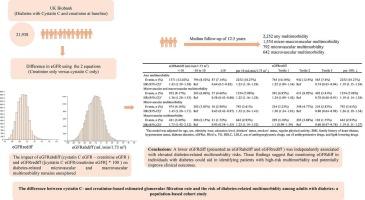成人糖尿病患者中基于胱抑素C和肌酐的肾小球滤过率和糖尿病相关多病风险的差异
IF 7.4
3区 医学
Q1 ENDOCRINOLOGY & METABOLISM
引用次数: 0
摘要
目的评估基于胱抑素C和肌酐的肾小球滤过率(eGFRdiff)与糖尿病相关多病发生率之间差异的关系。方法:这项纵向队列研究纳入了21938名英国生物银行糖尿病患者,基线时无糖尿病相关微血管或大血管疾病。eGFRdiff计算为绝对差值(eGFRabdiff)和相对差值(eGFRrediff)。主要结局是任何多病的发生率。次要结局包括微血管-大血管、微血管和大血管多发病。采用Cox比例风险回归模型评估eGFRdiff与结局之间的关系。结果在12.5年的中位随访中,有2252例多发性疾病,1554例微血管-大血管多发性疾病,792例微血管多发性疾病,642例大血管多发性疾病。eGFRabdiff每降低10 mL/min/1.73 m2,发生多种疾病、微血管-大血管多种疾病、微血管多种疾病和大血管多种疾病的风险分别增加23%、22%、32%和23%。同样,eGFRrediff每降低10%,结果的风险就会增加。亚组分析得出一致的结果。结论较低的eGFRdiff值与糖尿病相关多病风险升高独立相关。这些发现表明,监测糖尿病患者的eGFRdiff有助于识别高风险多病患者,并有可能改善临床结果。本文章由计算机程序翻译,如有差异,请以英文原文为准。

Difference between cystatin C- and creatinine-based estimated glomerular filtration rate and risk of diabetes-related multimorbidity among adults with diabetes
Aims
To evaluate the association of discrepancies between cystatin C- and creatinine-based estimated glomerular filtration rate (eGFRdiff) with incident diabetes-related multimorbidity.
Methods
This longitudinal cohort study included 21,938 UK Biobank participants with diabetes and free of diabetes-related microvascular or macrovascular disease at baseline. eGFRdiff was calculated as both the absolute difference (eGFRabdiff) and the relative difference (eGFRrediff). Primary outcome was the incidence of any multimorbidity. Secondary outcomes included microvascular-macrovascular, microvascular, and macrovascular multimorbidity. Cox proportional hazard regression models were used to evaluate the associations between eGFRdiff and the outcomes.
Results
Over a median follow-up of 12.5 years, there were 2,252 cases of any multimorbidity, 1,554 cases of microvascular-macrovascular multimorbidity, 792 cases of microvascular multimorbidity, and 642 cases of macrovascular multimorbidity. Each 10 mL/min/1.73 m2 decrease in eGFRabdiff was associated with 23 %, 22 %, 32 % and 23 % higher risk of any multimorbidity, microvascular-macrovascular multimorbidity, microvascular multimorbidity, and macrovascular multimorbidity, respectively. Similarly, each 10 % decrease in eGFRrediff corresponded to increase the risk of outcomes. Subgroups analyses yielded consistent results.
Conclusions
Lower eGFRdiff values were independently associated with elevated diabetes-related multimorbidity risks. These findings suggest that monitoring eGFRdiff in individuals with diabetes could aid in identifying patients with high-risk multimorbidity and potentially improve clinical outcomes.
求助全文
通过发布文献求助,成功后即可免费获取论文全文。
去求助
来源期刊

Diabetes research and clinical practice
医学-内分泌学与代谢
CiteScore
10.30
自引率
3.90%
发文量
862
审稿时长
32 days
期刊介绍:
Diabetes Research and Clinical Practice is an international journal for health-care providers and clinically oriented researchers that publishes high-quality original research articles and expert reviews in diabetes and related areas. The role of the journal is to provide a venue for dissemination of knowledge and discussion of topics related to diabetes clinical research and patient care. Topics of focus include translational science, genetics, immunology, nutrition, psychosocial research, epidemiology, prevention, socio-economic research, complications, new treatments, technologies and therapy.
 求助内容:
求助内容: 应助结果提醒方式:
应助结果提醒方式:


